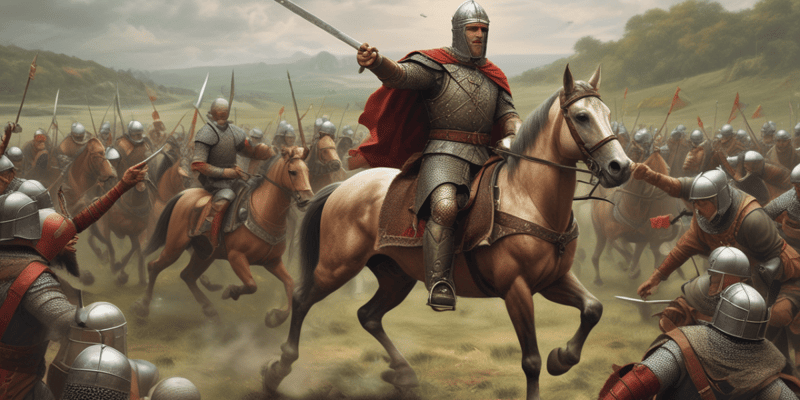10 Questions
What event marked a pivotal moment in English history and resulted in the Norman Conquest?
The Battle of Hastings
Why did King Edward the Confessor designate William, Duke of Normandy, as his successor?
Due to their shared Norman heritage
What was one of William the Conqueror's notable qualities that helped him acquire the English throne?
Being a skilled military leader and diplomat
Where did the Battle of Hastings take place geographically?
Hastings
Which battle did King Harold II win before marching south to face William's invading army at Hastings?
The Battle of Stamford Bridge
What advantageous positioning did William believe would not guarantee victory?
Positioning of infantry
Which factor eventually wore down the English in the Battle of Hastings?
William's cavalry and archers
What event led to the beginning of the English line crumbling in the Battle of Hastings?
Fatal wounding of Harold
Where was William crowned king after the Battle of Hastings?
London
How did William's reign impact England beyond the conflict and rebellion?
It resulted in linguistic changes.
Study Notes
The Battle of Hastings and William the Conqueror
The Battle of Hastings, fought on October 14, 1066, marked a pivotal moment in English history, ultimately resulting in the Norman Conquest. The story of this conflict and its central figure, William the Conqueror, reveal a clash of cultures, strategical prowess, and the consequences of ambition.
The Context of the Norman Conquest
King Edward the Confessor, who ruled England from 1042 until his death in 1066, had no clear heir. He did, however, designate William, Duke of Normandy (France), as his successor, reportedly due to the two men's shared Norman heritage. Edward's death triggered a race for the English throne, leading to multiple battles and a decisive victory for William at Hastings.
William the Conqueror
Born around 1028, William claimed descent from Robert the Magnificent, the first duke of Normandy. He was a formidable military leader, a shrewd diplomat, and a skilled politician. William's rise to power, from his early military campaigns against rebellious Normans and French nobles to his eventual acquisition of the English throne, solidified his reputation as a determined and cunning ruler.
The Battle of Hastings
King Harold II of England, having secured a victory at Stamford Bridge against Harald Hardrada and Tostig, marched south to face William's invading army. The battle took place on a ridge northwest of Hastings, with Harold's forces occupying the high ground. William, however, knew that advantageous positioning would not guarantee victory, and he moved quickly to force the confrontation.
The Norman knights, with their light armor and horses, were mismatched against the English infantry, who had formed a "shield wall" formation. The Normans, however, had an advantage in their use of missile weapons, such as arrows and javelins, which they could deploy from the safety of their horses.
Despite early success for Harold's forces, William's cavalry and archers eventually wore down the English, who lacked the numbers and fresh troops to endure the battle's duration. By late afternoon, Harold was fatally wounded by an arrow, and the English line began to crumble.
The Aftermath
After the battle, William's army moved to isolate London, where he was crowned king on December 25, 1066. William's reign, while marked by conflict and rebellion, also left a lasting legacy of cultural, linguistic, and architectural change in England. The Battle of Hastings, and the figure of William the Conqueror, would forever shape the history of England and the world.
Geographical Location and Alternative Sites
The traditional location of the battle has been Battle Hill, near Battle Abbey in East Sussex. However, some scholars have suggested alternative locations, such as Caldbec Hill, Sedlescombe, or Crowhurst, due to differences in terrain and topography. Despite these alternative theories, the Battle of Hastings' traditional location remains the most widely accepted.
The Battle of Hastings and its central figure, William the Conqueror, serve as a reminder of the profound influence of culture, leadership, and geography on the course of history. William's astute decisions and military strategy led to the fall of the Anglo-Saxon monarchy and the rise of the Norman dynasty, initiating a period of change that would shape England for centuries to come.
Explore the pivotal Battle of Hastings in 1066 and its central figure, William the Conqueror, whose strategic prowess and ambition led to the Norman Conquest of England. Learn about the clash of cultures, military tactics, and historical consequences in this significant event.
Make Your Own Quizzes and Flashcards
Convert your notes into interactive study material.
Get started for free


